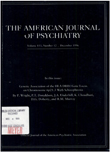Epidemiology and comorbidity of anxiety disorders in the elderly
Abstract
OBJECTIVE: The author reviewed the epidemiology and comorbidity of anxiety disorders in the elderly. METHOD: Data from 1970 onward were obtained through a computerized literature search, a review of Index Medicus, and the bibliographies of retrieved articles. Eight random- sample community surveys of anxiety disorders in persons 60 years of age or older were identified. Studies relating to the comorbidity of late-life anxiety and depression, dementia, alcoholism, and medical illness were also reviewed. RESULTS: The majority of studies showed that anxiety disorders are less common in the elderly than in younger adults. Generalized anxiety disorder and phobias account for most anxiety in late life; panic disorder is rare. Agoraphobia, and possibly obsessive-compulsive disorder in females, may occur as a primary disorder for the first time in old age, whereas simple phobia, obsessive-compulsive disorder in males, and panic disorder either persist from younger years or arise in the context of another psychiatric or medical disorder. There is considerable comorbidity of geriatric depression and generalized anxiety disorder and phobias, although the depression usually goes untreated or is inappropriately treated with benzodiazepines. The rate of comorbidity of anxiety and medical illness and alcoholism is lower in the elderly than in younger persons. CONCLUSIONS: Epidemiologic data on the prevalence of posttraumatic stress disorder (PTSD) and the first occurrence of generalized anxiety disorder and PTSD in late life are still needed. Further comorbidity studies are needed to determine the extent to which anxiety arises secondary to depression, as well as the optimal treatment and prognosis for this mixed state.
Access content
To read the fulltext, please use one of the options below to sign in or purchase access.- Personal login
- Institutional Login
- Sign in via OpenAthens
- Register for access
-
Please login/register if you wish to pair your device and check access availability.
Not a subscriber?
PsychiatryOnline subscription options offer access to the DSM-5 library, books, journals, CME, and patient resources. This all-in-one virtual library provides psychiatrists and mental health professionals with key resources for diagnosis, treatment, research, and professional development.
Need more help? PsychiatryOnline Customer Service may be reached by emailing [email protected] or by calling 800-368-5777 (in the U.S.) or 703-907-7322 (outside the U.S.).



